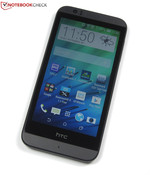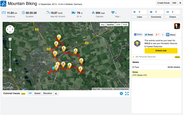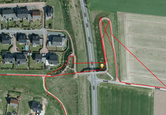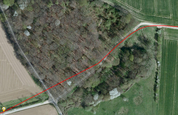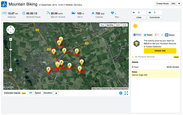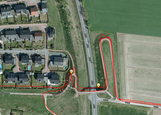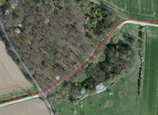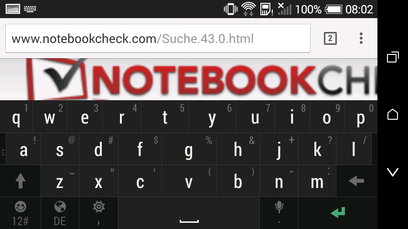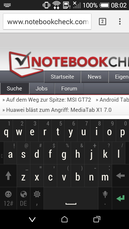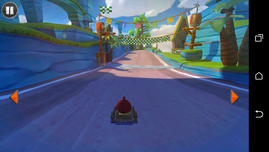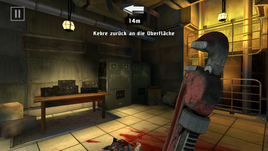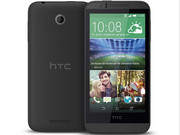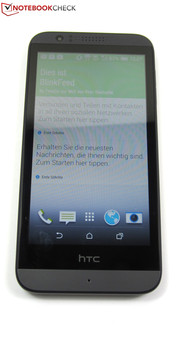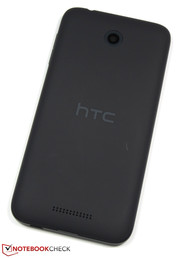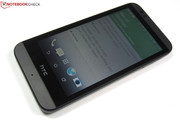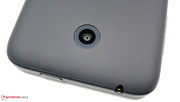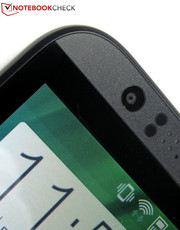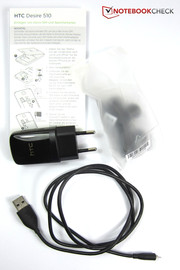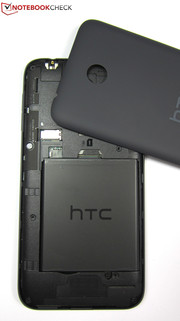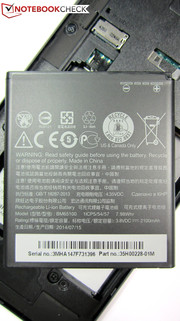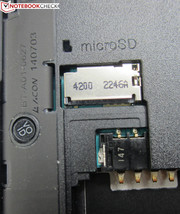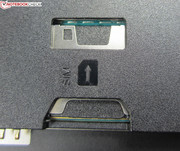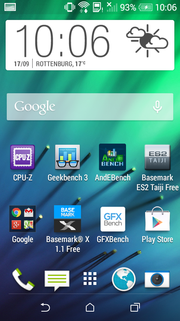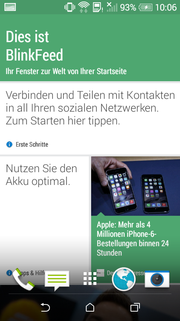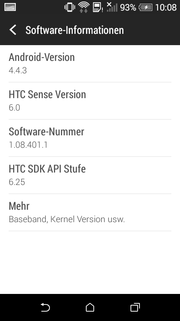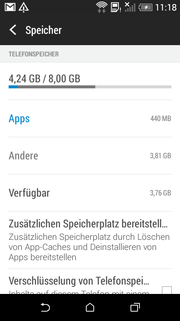HTC Desire 510 Smartphone Review

For the original German review, see here.
So why exactly should one consider the HTC Desire 510? According to the manufacturer, it's the combination of value and features that make the smartphone so appealing. The Android 4.4 smartphone comes equipped with a powerful middle-class quad-core Qualcomm Snapdragon 410 SoC and sells for just 200 Euros (~$250). HTC might have been forced to cut some corners here and there, but all in all we can't find many areas to complain about.
Case
The Desire 510 features a sturdy polycarbonate case. Thanks to high tolerances and almost non-existent gaps in the transition areas, the smartphone appears as if made from one piece. The slightly rubberized back gives the fingers something to hold on to, while the glass front covers almost the full width, which makes the 4.7-inch Android smartphone look larger than it really is. The black bezel surrounding the LCD display takes away from that effect a little, but that, of course, doesn't impact working with the phone one bit.
At exactly 9.99 mm thick, the HTC Desire 510 is a bit thicker than the HTC Desire 610, which measures 9.66 mm. From the other phones in our comparison, the Sony Xperia T3 is the thinnest phone at 7.7 mm, while the LG G2 Mini the lightest at 125 g.
Connectivity
The HTC Desire 510 comes with an ARM-based Qualcomm Snapdragon 410 - one of the first 64-bit mobile processors. The four cores of the SoC operate at 1.2 GHz. The 64-bit capability is not really an advantage yet, since Android isn't optimized for this CPU architecture.
In addition to the quad-core SoC, the smartphone features a Qualcomm Adreno 306 GPU, 1 GB of RAM, and 8 GB of total storage. Because of the Android OS and the many preinstalled applications, only about 3.8 GB is available for user-installed programs and data. The HTC Desire 510 supports MicroSD cards up to 128 GB, so expanding the storage is not that difficult.
The Qualcomm SoC not only supports the common wireless standards WLAN 802.11 b/g/n and Bluetooth 4.0, but also GPS and GLONASS satellite services and 2G/3G as well as LTE.
Software
The Desire 510 runs the current Android OS version 4.4.3. HTC has once again implemented their BlinkFeed app on the start page, which consolidates news, various feeds, updates, and social content. Quite a few apps are preinstalled: In addition to the Google staples Gmail, Maps, and Drive, there is also the YouTube app, a file manager, and the office suite Polaris Office 5.
Communication & GPS
The communication capabilities of the smartphone certainly don't disappoint. The HTC Desire 510 supports GSM Quad-band (850/900/1800/1900 MHz) and UMTS Tri-band (850/900/2100 MHz), which allows the phone to be used pretty much anywhere. Since the Desire supports LTE, browsing is exceptionally quick. Although HTC lists the frequency bands (B3, B7, and B20), the maximum possible transfer rate isn't mentioned. Combined with HSPA+, the phone is supposed to reach UMTS download speeds of up to 42 Mbit/s. The smartphone supports the wireless standards 802.11 b/g/n, Bluetooth 4.0 and DLNA. Wi-Fi connectivity uses the 2.4 GHz band; the 5 GHz band is not supported. During our time with the review unit we never experienced any sort of connectivity issues.
The Desire 510 supports the GPS system used in the US as well as the Russian counterpart GLONASS. During our test, we were able to establish a location lock rather quickly with a high degree of accuracy, no matter if we stayed outside or tried indoors.
We also compared the accuracy of the HTC Desire 510 to the higher-end GPS Garmin Edge 500. During a 10-kilometer bike test ride, the smartphone was off the mark at times, but overall had no issues pinpointing our exact location.
Telephony and Sound Quality
The HTC Desire 510 offers very good voice and sound quality no matter if calls are placed to other mobile phones or from the device to a landline phone. The integrated speaker reproduces voices clearly and we had no issues understanding our communication partner on the other end.
Cameras & Multimedia
Although the main camera supports a theoretical resolution of up to 5 megapixels, the camera menu allows the user to select a maximum of only 4 megapixels (2560x1440 pixels). The webcam only offers VGA quality (640x480 pixels), which is barely good enough for video chats and snapshots. The main camera, unfortunately, isn't that great either and produces flat-looking photos with unnatural colors; the details are washed out and sharpness is decidedly lacking as well. The camera quality of the HTC Desire 510 pales in comparison to the Apple iPhone 5 or the Nokia Lumia 1020.
Accessories & Warranty
HTC includes a Micro-USB cable, a power adapter, and a quick-start guide. Available accessories include Bluetooth stereo headphones and the HTC Battery Bar. In Germany, the phone is warranted against manufacturer's defects for a period of 24 months.
Input Devices & Operation
Operation of the Android 4.4 OS and the installed applications is smooth and quick. Because of the "Fast Start" capability (which is active by default), the Desire 510 is ready for user inputs after about 15 seconds. The Desire 510 translates any inputs very quickly, regardless if the user chooses to operate the smartphone via the three Android buttons at the bottom of the screen, the capacitive touchscreen, or by tilting and rotating the device.
The LCD display can recognize up to five fingers at the same time and allows for very accurate control of the various menus and apps. The Desire 510 also supports multi-touch gestures like zooming without any problems. The QWERTY keyboard takes up about half the screen when the phone is in portrait mode; in landscape mode, it's about two-thirds. Although the visible screen content is reduced significantly, typing is now exceptionally easy since the virtual keys are quite large.
Display
Many inexpensive smartphones with 4.7-inch displays don't support HD resolution. The HTC Desire 510 follows suit and features a resolution of 854x480 pixels (FWVGA). Although the display doesn't appear pixelated at all, a comparison with an HD smartphone clearly shows how much sharpness increases with a higher pixel count. The Nokia Lumia 625 (800x480 pixels), the HTC Desire 610 and the LG G2 Mini (both 960x540 pixels) feature similar resolutions.
The average brightness of 371.3 cd/m² is high enough even for bright environments. Most competing smartphones are equally bright, although the Sony Xperia T3 clearly outperforms the other smartphones with 503.6 cd/m. The black value of 0.37 cd/m² allows for sufficiently dark blacks, although colors appear a little washed out despite the high contrast ratio of 959:1. The brightness distribution (80%) isn't that great either, but that isn't noticeable at all during normal use.
| |||||||||||||||||||||||||
Brightness Distribution: 80 %
Center on Battery: 355 cd/m²
Contrast: 959:1 (Black: 0.37 cd/m²)
ΔE Color 12.13 | 0.5-29.43 Ø5
ΔE Greyscale 14.77 | 0.57-98 Ø5.3
Gamma: 2.42
Our analysis with the X-Rite i1Pro 2 spectrophotometer and CalMAN software shows that the display isn't very accurate. The white point of 10837 K is not even close to the ideal 6500 K, which results in a very "cool" representation of the various colors. The grayscales and color reproduction are also far from ideal with DeltaE values of 9.86 and 9.36, respectively. Of course, the Desire 510 can still handle typical tasks like surfing the web, looking at photos, or recording videos without any problems.
Thanks to the high average brightness of 371.3 cd/m², the HTC Desire 510 is very usable outdoors. The glossy display reflects light sources very well though, which can make it difficult to decipher the screen content in direct sunlight. We had no problems operating the phone in the shade or when the sky was overcast.
Performance
HTC uses a quad-core SoC from Qualcomm, the Snapdragon 410 MSM8916. The CPU features four ARM Cortex A53 cores running at 1.2 GHz. An integrated Qualcomm Adreno 306 GPU handles the graphics.
The Desire 510 performed neck-and-neck with the other smartphones in our comparison during the synthetic benchmark tests. Since all phones feature similar hardware, we couldn't really determine a clear winner. The takeaway from our tests is that all the phones mentioned offer plenty of performance and can handle common applications and gaming workloads quite well.
| PassMark PerformanceTest Mobile V1 - System (sort by value) | |
| HTC Desire 510 | |
| HTC Desire 610 | |
| LG G2 Mini | |
| Sony Xperia T3 | |
| Epic Citadel - High Quality (sort by value) | |
| HTC Desire 510 | |
| HTC Desire 610 | |
| LG G2 Mini | |
| Sony Xperia T3 | |
| 3DMark - 1920x1080 Ice Storm Extreme Score (sort by value) | |
| HTC Desire 510 | |
| HTC Desire 610 | |
| LG G2 Mini | |
| Sony Xperia T3 | |
| AndEBench | |
| Native (sort by value) | |
| HTC Desire 510 | |
| HTC Desire 610 | |
| LG G2 Mini | |
| Sony Xperia T3 | |
| Java (sort by value) | |
| HTC Desire 510 | |
| HTC Desire 610 | |
| LG G2 Mini | |
| Sony Xperia T3 | |
The Desire 510 tackled the various browser benchmarks without issues and scored comparable to the HTC Desire 610. The smartphone performed particularly well when we ran the Octane V2 benchmark. Neither the Nokia Lumia 625 nor the Sony Xperia T3 could quite keep up with our review candidate as far as overall browsing performance is concerned.
| Peacekeeper - --- (sort by value) | |
| HTC Desire 510 | |
| HTC Desire 610 | |
| LG G2 Mini | |
| Nokia Lumia 625 | |
| Sony Xperia T3 | |
| Mozilla Kraken 1.1 - Total (sort by value) | |
| HTC Desire 510 | |
| HTC Desire 610 | |
| LG G2 Mini | |
| Sony Xperia T3 | |
| Octane V2 - Total Score (sort by value) | |
| HTC Desire 510 | |
| HTC Desire 610 | |
| LG G2 Mini | |
| Sony Xperia T3 | |
* ... smaller is better
All phones offer about the same read and write performance, although the LG G2 Mini pulled ahead of the pack. The HTC Desire 510 keeps up in most areas but falls slightly behind when forced to handle sequential writes.
| AndroBench 3-5 | |
| Sequential Read 256KB (sort by value) | |
| HTC Desire 510 | |
| HTC Desire 610 | |
| LG G2 Mini | |
| Sony Xperia T3 | |
| Sequential Write 256KB (sort by value) | |
| HTC Desire 510 | |
| HTC Desire 610 | |
| LG G2 Mini | |
| Sony Xperia T3 | |
| Random Read 4KB (sort by value) | |
| HTC Desire 510 | |
| HTC Desire 610 | |
| LG G2 Mini | |
| Sony Xperia T3 | |
| Random Write 4KB (sort by value) | |
| HTC Desire 510 | |
| HTC Desire 610 | |
| LG G2 Mini | |
| Sony Xperia T3 | |
Gaming Performance
We had no issues playing current games like Angry Birds Go, Real Racing 3, Shadowgun: Deadzone and Dead Trigger 2, which all performed smoothly. Control input was very precise via the touchscreen and the acceleration sensor.
Emissions
Temperature
With a maximum temperature of 38.2 °C under load, the Desire 510 actually stays pretty cool. We measured an even lower temperature of 32.3 °C during idle. The LG G2 Mini is the coolest phone of the bunch at 36.2 °C, while the Sony Xperia T3 can be considered "hot" at 46 °C.
(+) The maximum temperature on the upper side is 38.2 °C / 101 F, compared to the average of 35 °C / 95 F, ranging from 21.9 to 56 °C for the class Smartphone.
(+) The bottom heats up to a maximum of 37.6 °C / 100 F, compared to the average of 33.8 °C / 93 F
(+) In idle usage, the average temperature for the upper side is 30 °C / 86 F, compared to the device average of 32.7 °C / 91 F.
Speakers
As expected, the small speaker on the back of the Desire 510 delivers lackluster sound quality. Highs dominate the sound stage and lows and bass are missing completely. At least there is no noticeable distortion even at maximum volume level. The included stereo headphones improve the sound quality significantly.
Energy Management
Power Consumption
The Desire 510 is powered by a swappable lithium-polymer battery, which offers a capacity of 7.98 Wh. HTC promises a maximum power consumption of 5.2 watts, which is actually pretty frugal. All competing smartphones require less power, however. Even Sony's 5.2-inch Xperia T3 tops out at only 4.9 watts and the LG G2 Mini requires less than half the power of the Desire 510 at 2.4 watts.
| Off / Standby | |
| Idle | |
| Load |
|
Battery Life
The HTC Desire 510 offers decent runtimes. Depending on the test, we recorded between 4 hours and 22 minutes (maximum load) and 21 hours and 20 minutes (idle). We ran our WLAN test, which most closely simulates real-world performance, at a display brightness of 140 cd/m²and with power-saving measures activated. The phone lasted for 9 hours and 30 minutes, which should be sufficient for a full workday. The competition does it even better though: The Sony Xperia T3 lasted for 10 hours and 34 minutes, the Nokia Lumia 625 12 hours and 43 minutes, and the LG G2 Mini a whopping 16 hours and 43 minutes.
Verdict
The HTC Desire 510 is a good 4.7-inch smartphone which isn't really missing any features despite the low MSRP of 200 Euros (~$250). Equipped with a quad-core SoC and Android 4.4.3, the Desire 510 offers good overall performance and a decent gaming experience as well. We appreciate the high build quality and the wireless modules, which not only support GMS and UMTS, but they also allow fast Internet connectivity thanks to LTE.
Of course, there are a few drawbacks as well: The display resolution of 854x480 pixels leaves something to be desired and viewing-angle stability could definitely be better. The integrated camera modules offer subpar picture quality and are just barely sufficient for snapshots. Only 3.8 GB of space is available for user-installed applications, videos and photos, although MicroSD cards (up to 128 GB) allow the user to alleviate space issues rather easily.


 Deutsch
Deutsch English
English Español
Español Français
Français Italiano
Italiano Nederlands
Nederlands Polski
Polski Português
Português Русский
Русский Türkçe
Türkçe Svenska
Svenska Chinese
Chinese Magyar
Magyar